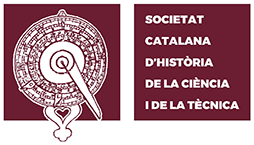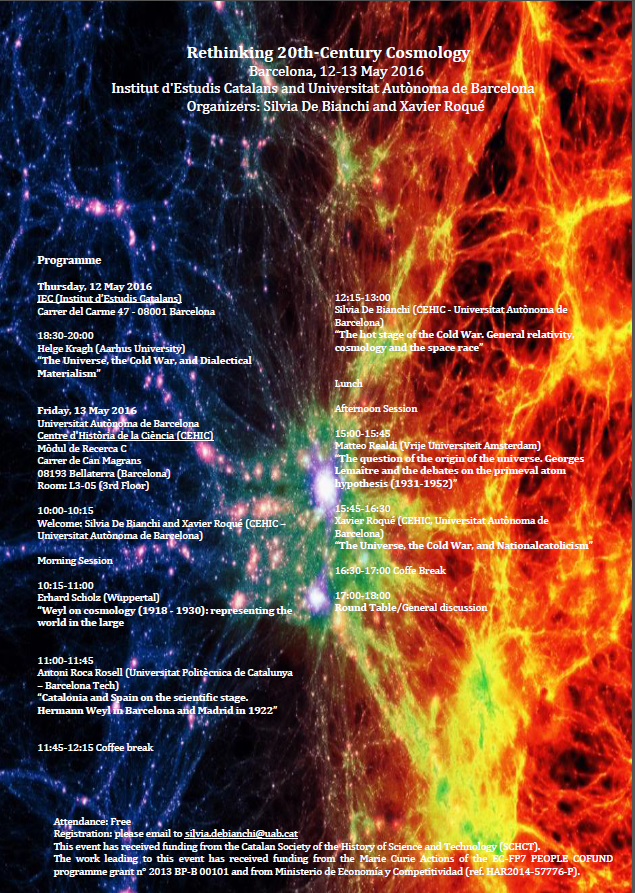Re-thinking 20th Century Cosmology
Coordinadors: Silvia De Bianchi i Xavier Roqué Rodríguez (CEHIC)
Resum:
In the occasion of the centennial celebration of Einstein’s general relativity theory and his cosmological hypothesis, this workshop aims at exploring the development of 20th-century cosmology from different perspectives and by using different approaches.
Recent studies in technology and global history, such as Edgerton’s (2011), Nye’s (2006), and Siddiqi’s (2010) suggest to look for the technological devices deployed for other purposes, such as those of space science (e.g. satellites) that thanks to their diffusion, allowed the testability and the reproducibility of experimental results concerning relativity theory and fostered the research of the evidence for cosmological models. This approach throws a fresh-light on our historical understanding of the theory of relativity and suggests to deepen it, by including the debate on cosmology during the Cold War within the context of global history. Another approach consists in considering the dialectic cooperation/competition between state-Nations as a key-concept in order to understand the processes at stake in the space race, but also the ideological implication of strategic choices in national space science programs that anyway implied an International cooperation behind them.
By framing cosmology within the context of technological advancement produced during the Cold War, it can be shown not only how and why the experimental testability of the general theory of relativity had been made possible. Furthermore, it can be investigated how Soviet science reacted to the increase of experiments confirming general relativity theory from 1960 onwards.
“The Universe, the Cold war, and Dialectical Materialism”
Prof. Helge Kragh (Aarhus University)
Thursday, 12 May 2016, 18.30h PLENARY LECTURE (Institut d’Estudis Catalans)
During parts of the Cold War period cosmology in general and finite cosmological models in particular were regarded as politically incorrect in the Soviet Union. Not only did such conceptions of the universe contradict dogma of dialectical materialism, they were also accused of introducing religious concepts in science. The result of the ideological campaign against Western-style cosmology was that very few Soviet scientists contributed to cosmological research. The communist propaganda and suppression of cosmological theories lasted longer and was more pervasive in Red China, where finite-age theories were de facto forbidden until the late 1970s. The development in the two countries provides an instructive case study of the intervention of political ideology in twentieth-century physical and astronomical science.
ONE-DAY WORKSHOP
Friday 13 May 2016
Centre for the History of Science (CEHIC), Universitat Autònoma de Barcelona
Mòdul de Recerca C, c/ de can Magrans s/n
10.15-11-00 h
Erhard Scholz (Wuppertal), “Weyl on cosmology (1918-1930): representing the world in the large”
Weyl entered the Einstein-de Sitter discourse on general relativistic cosmology about 1921, at first as a strong defender of Einstein’s emphasis of a Machian cosmology, but also attracted by the mathematical beauty of de Sitter’s non-Machian (matter free) universe. At the time of the 5th edition of Raum-Zeit-Materie (1923) he had developed a perspective of his own, in which he implemented a pencil of timelike trajectories as a constitutive feature for describing the “world in the large” (i.e. for a cosmological model). Also in 1923 he analyzed cosmological redshift as a kinematic effect of diverging cosmological flow-lines and derived an approximately linear relationship between distances of nebulae and spectral shift. From the rudimentary spectral data of nebulae, available at the time, he concluded a value about 60% higher than Hubble’s five year later. In the late 1920s and at the turn to the 1930s a new generation of relativists took over (Friedman, Lemaitre, Robertson et al.). In 1930 Weyl discussed the status of cosmological redshift again, still fully in agreement with using the geometric/kinematical hypothesis for cosmological redshift as the best mathematical tool for its analysis; but he also added his expectation that some day it might be replaced by a “more physical” (i.e. field theoretic) explanation.
11.00-11.45 h
Antoni Roca Rosell (Universitat Politècnica de Catalunya – Barcelona Tech), “Catalonia and Spain on the scientific stage. Hermann Weyl in Barcelona and Madrid in 1922”
It is well known that Spanish research on physics began to be institutionalised in the 1910-1920s. Although experimental fields were more developed, there were attempts to promote mathematical physics, especially with the collaboration of centres of mathematics. Research was promoted by some institutions in three ways: sending students abroad to specialize; creating new centres of research; and inviting foreign researchers to reinforce the existing lines of research. In Barcelona, in 1914 the local government set up a programme of monographic courses of “higher studies” with the idea of exchanging teachers with centres in Europe. The participation of foreign researchers was prevented by the outbreak of the First World War. After the war, several outstanding scientists were invited. The lectures of Hermann Weyl in Barcelona and Madrid in 1922 were included in the monographic courses on physics and mathematics coordinated by E. Terradas. Between 1919 and 1923, Levi-Civita, Hadamard, Weyl, Sommerfeld and Einstein visited Barcelona and Madrid and the emergent scientific community had the opportunity to make contact with them. The course prepared by Hermann Weyl was based on his research at the time, which was centred on the problem of space. The corresponding publication of the notes he prepared constituted a remarkable book that was published in Germany in 1924. In this paper, we analyse the context of the 1922 invitation to Hermann Weyl, and we evaluate the impact of his lessons. We consider the role played by E. Terradas in Barcelona, who planned the visit, and that of Josep M. Plans in Madrid, who was interested in developing an original line of research concerning the problem of space.
12:15-13:00
Silvia De Bianchi (CEHIC – Universitat Autònoma de Barcelona), “The hot stage of the Cold War. General relativity, cosmology and the space race”
The “Experimental tests of theories of relativity” NASA Conference took place at Stanford University in 1961. The summary of this event was published in Physics Today. The importance of this event emerges in one of the most influencial books in the history and philosophy of science. In the “Structure of Scientific Revolutions” (1962), indeed, Thomas Kuhn mentions this report in the context of scientific theory-testing. I shall frame the 1961 conference within the broader framework of the collaboration and competition between United States and USSR. The second half of the 20th Century, indeed, witnessed the improvement of space science leading to a large-scale testing of the general theory of relativity and cosmological models. Within the American programme, I shall consider the prominent contributions of figures, such as F. Zwicky and H. P. Robertson, the chairman of the NASA conference in 1961. By considering also Soviet sources, I shall reconstruct the origin of experiments pursued by both US and USSR within the context of space race (until 1972).
Lunch
15:00-15:45
Matteo Realdi (Vrije Universiteit Amsterdam), “The question of the origin of the universe. Georges Lemaître and the debates on the primeval atom hypothesis (1931-1952)”
The Belgian priest Georges Lemaître (1894-1966) was one of the key-actors during the early phases of relativistic cosmology. Indeed, Lemaître proposed a dynamical solution of the relativistic field equations that coherently described the expanding universe (1927). Moreover, he hypothesized a natural beginning of the world from what he called the “primeval atom” (1931). This hypothesis of a very initial state of the universe soon became an issue of discussion and controversy, both at the scientific and the metaphysical level. This talk will focus on the position of Lemaître in the debates on the origin of the universe in which he was involved, especially in the period 1931-1952. Through the analysis of his scientific articles, popular writings, and correspondence, it will describe Lemaître’s view on modern cosmology, as well as his defence of the autonomy of science as a separate field from theology.
15:45-16:30
Xavier Roqué (CEHIC, Universitat Autònoma de Barcelona), “The Universe, the Cold War, and Nationalcatolicism”
In order to make it politically correct, Spanish physicists and astronomers through Francoism and the Cold War made religious readings of cosmology. These ideological statements were not seen as interferences with the normal course of science, but rather as a necessary guidance, and also as a way to place science within a wider hunanistic frame. I will discuss such cultural appropiations of cosmology in Francoism, relating them to the appropriation of quantum mechanical and relativistic concepts. I will also try to asses the effect of this cultural approach on the scientific practice and institutional development of cosmology in the dictatorship.
17.00-18:00 Round Table/general discussion
Helge Kragh, Erhard Scholz, Matteo Realdi, Antoni Roca Rosell, Xavier Roqué, Silvia De Bianchi



